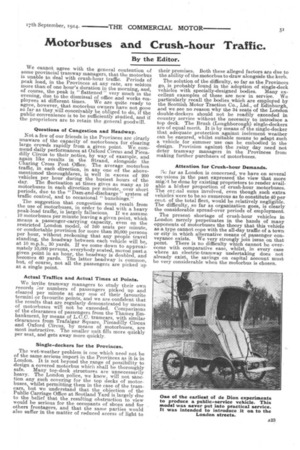Motorbuses and Crush-hour Traffic.
Page 17

If you've noticed an error in this article please click here to report it so we can fix it.
By the Editor.
We cannot agree with the general contention of some provincial tramway managers, that the motorbus is unable to deal with crush-hour traffic. Periods of peak load, in the Provinces at any rate, are seldom more than of one hour's duration in the morning, and, of course, the peak is " flattened " very much in the evening, due to the dismissal of office and works employees at different times. We are quite ready to agree, however, that motorbus owners have not gone BO far as they.wil/ conceivably be obliged to do, if the public convenience is to be sufficiently studied, and if the proprietors are to retain the general goodwill.
Questions of Congestion and Headway.
Not a few of our friends in the Provinces are clearly unaware of the capacity of motorbuses for clearing large crowds rapidly from a given point. We commend daily performances at Oxford Circus and Piccadilly Circus to their notice, by way of example, and again like results in the Strand, alongside the Charing Cross Post Office. The average motorbus traffic, in each direction, in any one of the abovementioned thoroughfares, is well in excess of 200 vehicles per hour during the busiest hours of the day. The fluctuation at times gives as many as 10 motorbuses in each direction per minute, over short periods, due to the "Dam-and-discharge" system of traffic control, and to occasional " bunchings."
The suggestion that congestion must result from the use of motorbuses, in order to deal with a heavy peak-load traffic, is largely fallacious. If we assume 10 motorbuses Per minute leaving a given point, which means a passenger-carrying capacity, even on the restricted London model, of 340 seats per minute, or comfortable provision far more than 20,000 persons per hour, without reckoning that any people travel standing, the headway between each vehicle will be, at 10 m.p.h., 30 yards. If we come down to approximately 10,000 persons, everybody seated, moved past a given point in an hour, the headway is doubled., and becomes 60 yards. The latter headway is common, but, of course, not all the passengers are picked up at a. single point.
Actual Traffics and Actual Times at Points.
We invite tramway managers to study their own records or numbers of passengers picked up and cleared per minute at any one of their favourite terraini or favourite points, and we are confident that the results that are regularly demonstrated by means of motorbuses will not be exceeded. Comparisons of the clearances of passengers from the Thames Embankment, by means of L.C.C. tramcars, with similar clearances from Trafalgar Square, Piccadilly Circus and Oxford Circus, by means of motorbuses, are most instructive. The smaller unit fills more quickly per seat, and gets away more quickly.
Single-deckers for the Provinces.
The wet-weather problem is one which need not be of the same serious import in the Provinces as it is in London. It is not beyond the range of possibility to design a covered motorbus which shall be thoroughly safe. Many top-deck structures are unnecessarily heavy. The London police, we know, will not sane tion any such covering for the top decks of motor buses, whilst permitting them in the case of the tramcars, but we understand that the objection of the Public Carriage Office at Scotland Yard is largely due to the belief that the resulting obstruction to view would be serious for the occupants of shops and for others frontagers, and that the same parties would also suffer in the matter of reduced access of light to
their premises. Both these alleged factors. are due to the ability of the motorbus to draw alongside the kerb.
The solution of the difficulty, so far as the Provinces go, is probably found in the adoption of single-deck vehicles with specially-designed bodies. Many excellent examples of these are now in service. We particularly recall the bodies which are employed by the Scottish Motor Traction Co., Ltd., of Edinburgh, and we see no reason why the 34 seats of the London double-deekers should not be readily exceeded in country service without the necessity to introduce a top deck. The Brush (Loughborough) single-deckers are of equal merit. It is by means of the single-decker that adequate protection against inclement weather can be ensured, whilst suitable means to adapt such a vehicle for summer use can be embodied in the design. Provision against the rainy day need not deter tramway managers in the Provinces from making further purchases of motorbuses.
Attention for Crush-hour Demands.
So far as London is concerned, we have on several occasions in the past expressed the view that more mig:It be done by existing proprietors to render available a higher proportion of crush-hour motorbuses. The car.Ltal sums involved, even though such extra vehicles were to be so numerous as to constitute 40 per cent. of the total fleet, would be relatively negligible. The difficulty, so far as organization goes, is clearly the considerable spread-over periods of employment.
The present shortage of crush-hour vehicles in London merely perpetuates in the hands of many opponents of motorbuses the theory that this vehicle as a type cannot cope with the all-day traffic of a town or city in which alternative means of passenger conveyance exists. We very strongly join issue on that point. There is no difficulty which cannot be overcome with comparative ease, whilst, in every case where an electric-tramway undertaking does not already exist, the savings on capital account must be very considerable when the motorbus is chosen.






















